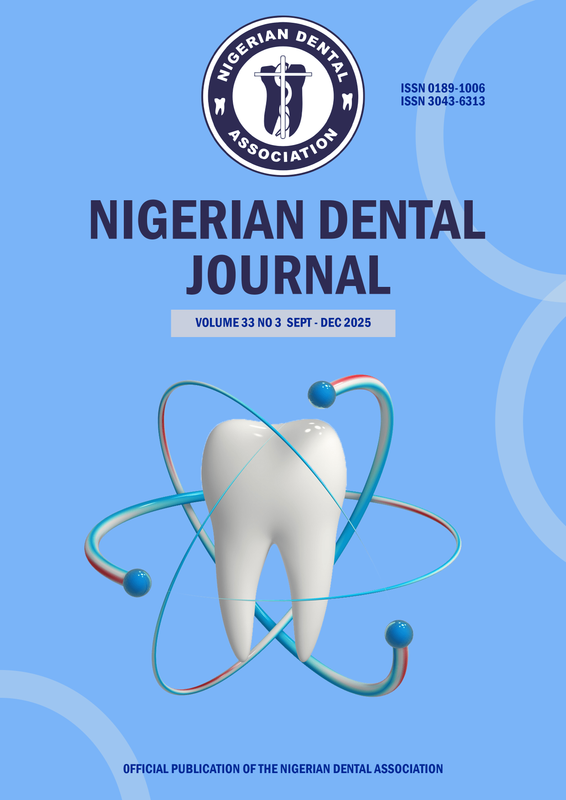PRESENTATION AND MANAGEMENT OF DENTAL FLUOROSIS IN A RESOURCE LIMITED FACILITY.
DOI:
https://doi.org/10.61172/ndj.v30i2.220Keywords:
dental fluorosis, Management, Presentation, Nigerian populationAbstract
Background: Dental fluorosis is a developmental disturbance characterized by excess fluoride in hard tissues of the teeth. The appearance of teeth affected by dental fluorosis may negatively affect individual self-esteem and overall quality of life. Thus, the need for treatment, though there is still debate on the best treatment modalities. The objective of this study was to document the presentation and management of dental fluorosis in a resource limited facility in north central Nigeria.
Methods: A cross-sectional hospital-based study conducted among out-patients attending a secondary oral health care facility in Jos, north central Nigeria between June 2020 and June 2022. Sociodemographic characteristics were recorded. All patients were examined for presence of dental fluorosis. Dean’s Index was used to classify dental fluorosis. Patients with dental fluorosis who consented to the study were treated. Treatment modalities included oral prophylactic treatment, microabraision and resin infiltration. Data analysis was by the use of Statistical Package for Social Sciences (SPSS) version 23.0 A p-value of < 0.5 was taken as statistically significant.
Results: During the study period, 1201 patients presented with different oral health challenges. Among these 200 (16.7%) were diagnosed of dental fluorosis. The mean of the patients with dental fluorosis was 14.15 ± 1.91 years. Nearly half 98(49.0%) of the patients who presented with dental fluorosis were children, 65(32.5%) were teenagers and 37(18.5%) were young adults (p=0.037). Among the patients, 123 (61.5%) were females. The moderate type of dental fluorosis 75(37.5%) was the commonest type of dental fluorosis seen. Out of the 200 patients with dental fluorosis, dental caries was present among 55(37.5%) patients. 185(92.5%) requested for treatment. 231 intervention procedures were undertaken on different classes of dental fluorosis.
Conclusion: Dental fluorosis is prevalent among the dental out-patients seen at the study center during the study period. More patients presented with moderate class of dental fluorosis. Presentation was more among children and teenagers below 20 years. More female presented and requested for intervention than the males. Resin infiltration was found to be cost effective at this facility.
Downloads
References
Shahroom NSB, Mani G, Ramakrishnan M. Interventions in management of dental fluorosis, an endemic disease: a systematic review. J of Family Med Prim Care. 2019;8(10):3108-3113.
Idon, PI, Enabulele J. Prevalence, severity and request for treatment of dental fluorosis among adult in an endemic region of Northern Nigeria. Eur J Dent 2018;12(2):184
Akuno MH, Nocella G, Milia EP, Gutierrez L. Factors influencing the relationship between fluoride in drinking water and dental fluorosis: a ten-year systematic review and meta-analysis. J Water Health 2019;17(6): 845-862. https://doi.org/10.2166/wh.2019.300
Albanto AJ, Rezende KMP, Salazar MSM, Bucholdz TAF, Celibrerti P, Ciamponi AL. Dental fluorosis: exposure, prevention and management. Med Oral Oatol Oral Cir Bucal. 2009;14:E103-107.
Haritash AK, Aggarwal A, Soni J, Sharma K, Sapra M, Singh B. Assessment of fuoride in groundwater and urine, and prevalence of fuorosis among school children in Haryana, India. Appl Water Sci 2018;8:52.
World Health Organization (WHO). Basic methods for assessment of renal fluoride excretion in community prevention programmes for oral health. 2014, WHO. Geneva.
Aoba T, Fejerskov O. Dental fluorosis: chemistry and biology. Crit Rev Oral Biol Med. 2002;13:155-70.
Sananda D. Biplab G. Fluoride fact on human health and health problems: a review. Med Cli Rev 2016;2(1:2):1–6.
World Health Organization (WHO). Guidelines for Drinking Water Quality, 2014, 4th ed. WHO, Geneva.
Mohanta A, Mohanty PK. Dental fluorosis-–revisited. Biomed J Sci Technol Res 2018;2:2243–2247. doi:10.26717/BJSTR.2018.02.000667.
Rango T, Kravchenko J, Atlaw B, McCornick PG, Jeuland M, Merola B. et al. Groundwater quality and its health impact: an assessment of dental fluorosis in rural inhabitants of the main Ethiopian Rift. Environ Int 2012;43:37–47.
O'Mullane DM, Baez RJ, Jones S, Lennon MA, Petersen PE, Rugg-Gunn AJ, et al. Fluoride and oral health. Community Dent. 2016;33:69–99.
Del Carmen AF, Javier FH, Aline CC. Dental fuorosis, fuoride in urine, and nutritional status in adolescent students living in rural areas of Guanajuato, Mexico. J Int Soc Prev Community Dent. 2016;6(6):517–522.
Rango T, Vengosh A, Jeuland M, Tekle-Haimanot R, Weinthal E, Kravchenko J, et al. Fluoride exposure from groundwater as reflected by urinary fluoride and children’s dental fluorosis in the Main Ethiopian Rift Valley. Sci Total Environ. 2014;496:188–19.
Okoye LO, Ekkwueme OC, Sote EO, Amaechi BT. Prevalence of dental fluorosis among12-15-year-old students in Enugu Metropolis, Nigeria. Indian J Dent Res 2019;30(3):462-467.
Ajayi D, Arigbede A, Dosumu OO, Ufomata D. The prevalence and severity of Dental Fluorosis among secondary school children in Ibadan, Nigeria. Postgrad Med J 2012;19(2):102-6.
Dean HT. The Investigation of physiological effects by the epidemiological method. In: Moulton FR (ed). Fluorine and dental health. Washington, DC: American Association for the Advancement of Science, Publication No. 1942;19:23–31.
Whelton HP, Ketley CE, McSweeney F, O’Mullane DM. A review of fluorosis in the European Union: Prevalence, risk factors and aesthetic issues. Community Dent Oral Epidemiol 2004;32(1):9-18.
Clark DC, Hann HJ, Williamson MF, Berkowitz J. Aesthetic concern of children and parents in relation to different classifications of the Tooth Surface Index of fluorosis. Community Dent Oral Epidemiol 1993;21(6):360-364.
Curtis AM, Levy SM, Cavanaugh JE, Warren JJ, Kolker JL, Weber-Gasparoni K. Decline in dental fluorosis severity during adolescence: a cohort study. J Dent Res. 2020;99(4):388-394.
Verma A, Shetty BK, Guddattu V, Chourasia MK, Pundir P. High prevalence of dental fluorosis among adolescents is a growing concern: a school based cross-sectional study from Southern India. Environ H Prev Med 2017;22(1):1-7.
Singh DK, Singh RP. Prevalence of dental caries in school going children of Patna. J Indian Dent Assoc. 1981;53:267.
Gopalakrishnan P, Vasan RS, Sharma PS, Nair KS, Hankappan KR. Prevalence of dental fluorosis and associated risk factors in Alappuzha district Kerala. Natl Med J India 1999;12(2):99-103.
Demirci M, Tuncer S, Yuceokur A. Prevalence of caries on individual tooth surfaces and its distribution by age and gender in university clinic patients. Eur J Dent 2010;4:270-277.
Arvind BA, Isaac A, Murthy NS, Shivaraj NS, Suryanarayana SP, Pruthvish S. Prevalence and severity of dental fluorosis and genu valgum among school children in rural field practice area of a medical college. Asian Pac J Trop Dis Asian Pac Trop Med Press 2012;2:465-469.
Sukhabogi JR, Parthasarathi P, Anjum S, Shekar BRC, Padma CM, Rani AS. Dental fluorosis and dental caries prevalence among 12- and 15-year-old school children in Nalgonda district, Andhra Pradesh, India Annals of Medical and Health Sciences Research. 2014;4(SUPPL 3): S245-S252.
Mane AB, Revathi S, Sarale DG, Paul CN, Hiremath SG. Studies of dental fluorosis among primary school children residing in rural area of Raschar district, Karnataka. Int J Biol Med Res 2011;2(3):716-720.
Singh M, Saini A, Saimbi CS, Bajpai AK. Prevalence of dental diseases in 5- to 14-year-old school children in rural areas of the Barabanki district, Uttar Pradesh, India. Indian J Dent Res. 2011;22:396–399.
Idowu EA, Afolabi AO, Fakuade BO, Akintububo OB, Ibiyemi O. Self-medication profile of Dental Patients Attending a North Eastern Tertiary Hospital in Nigeria. Ann Ibd. Pg. Med 2019;17(2):173-180.
Ogbebor OG, Azodo CC. Reasons for seeking dental healthcare services in a Nigerian missionary hospital. Sahara medical journal 2016;19(1):38-43.
Taghipour N, Amini H, Mosaferi M, Yunesian M, Pourakbar M, Taghipour H. National and sub-national drinking water fluoride concentrations and prevalence of fluorosis and of decayed, missed, and filled teeth in Iran from 1990 to 2015: a systematic review. Environ. Sci. Pollut. Res 2016;23:5077–5098.
Sebastian ST, Soman RR, Sunitha S. Prevalence of dental fluorosis among primary school children in association with different water fluoride levels in Mysore district, Karnataka. Indian J Dent Res 2016;27(2):151–154.
Fan Z, Gao Y, Wang W, Gong H, Guo M, Zhao S, et al. Prevalence of brick tea-type fluorosis in the Tibet autonomous region of China. J Epid 2016;26(2):57–63.
Garg I, Kumar A. Resin Infiltration for esthetic improvement of mild to moderate non-pitted fluorosis stains in 6-12-year-old Children: a randomized 6-month intervention study. J South Asian Assoc Pediatr Dent 2021;4(2):96-103.
Loguercio A, Correia L, Zago C, Tagliari D, Neumann E, Gomes O, et al. Clinical effectiveness of two microabrasion material for the removal of enamel fluorosis stains. Oper Dent. 2007;32:531-538.
Gugnani N, Pandit I, Goyal V, Gugnani S, Sharma J, Dogra S. Esthetic improvement of white spot lesions and non-pitted fluorosis using resin infiltration technique: series of four clinical cases, J Indian Sov Pedod Prev Dent. 2014;32:176.
Downloads
Published
Issue
Section
License
Copyright (c) 2023 Olaniyi Taiwo, Enoch Abiodun Idowu, Olushola Ibiyemi, Adedapo Afolabi

This work is licensed under a Creative Commons Attribution 4.0 International License.
Open Access Statement
- We became fully Open Access since January 2023.
- Our new and archived materials are available free of charge on open basis and under a Creative Commons license as stated below.
Copyright statement
Copyright © 1999 The authors. This work, Nigerian Dental Journal by Nigerian Dental Association is licensed under Creative Commons Attribution 4.0 International License.


